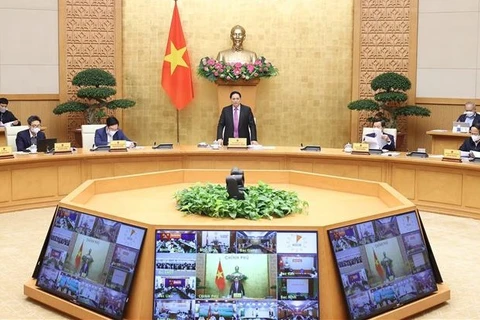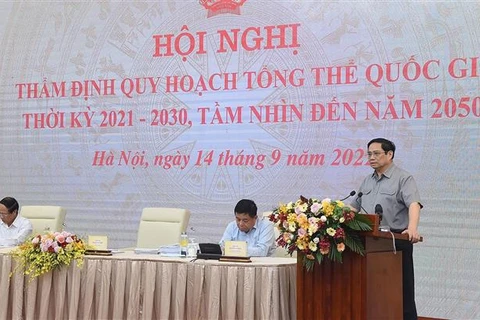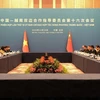
Hanoi (VNA) – The Ministry of Planning and Investment is continuing to research and fine-tune the draft National Master Plan for 2021-2030, with a vision to 2050, to submit it to the Government and later to the fourth session of the National Assembly for final approval.
A council especially set up to appraise the National Master Plan for 2021-2030, with a vision to 2050, met on September 14 to scrutinise the draft submitted by the Ministry of Planning and Investment.
At the meeting, Minister of Planning and Investment Nguyen Chi Dung said this is the first time Vietnam has ever built a National Master Plan following the 2017 Planning Law.
Evaluating current development status
Minister Dung emphasised that drafting the first National Master Plan is a new, important, challenging task without experience and precedent. However, it presents an excellent opportunity for the country to look closely at the current development status and assess the national development space in a substantial and all-encompassing manner.
“The master plan will define the directions, the space, the roadmap and resources for national development,” the minister said.
At the meeting, members of the evaluation council agreed that the draft master plan had been built scientifically and carefully with the involvement of ministries, agencies, sectors, localities, scientists, experts and international organisations.
They made some recommendations regarding the viewpoint, goals and scenarios of national development.
Prof. Dr La Ngoc Khue (former Deputy Minister of Transport), Dr Tran Dinh Thien (former director of the Vietnam Institute of Economics) and Dr Cao Viet Sinh (former Deputy Minister of Planning and Investment) proposed expanding the space for development to the sea and the sky.
Some said regional connectivity should be given more attention and suggested adding targets to reduce greenhouse gas emissions and treat industrial and daily wastewater by 2030.
The council members also proposed selecting the target of an annual GDP growth rate from 6.5%-7.5% for 2031-2050.
Specific targets
On the development of economic sectors, Dr Sinh and Assoc. Prof. Dr Pham Trung Luong (former director of the Institute for Tourism Development) suggested revising the goal of tourism development, setting the target of welcoming 47-50 million international visitors and raising tourism’s contribution to the national GDP to 14-15% by 2030.
Khue wants to supplement the investment in urban railways connecting with inter-regional railway routes to develop transport infrastructure networks.
Assoc. Dr Chu Hoi (former Deputy General Director of the Vietnam Administration of Seas and Islands) also believes that priority should be given to building new railways and inland waterways in connection with maritime in the 2021-2030 period.
Prof. Dr Dao Xuan Hoc (President of the Vietnam Irrigation Association) proposed that the development of irrigation infrastructure should include specific directions for the Red River delta (reviving rivers so that irrigation works can pump water any time) and the Mekong Delta (building dykes and river sluices to prevent flooding that co-exists with flooding and adapts to climate change).
Dr Dang Kim Son (former Director General of the Institute of Policy and Strategy for Agriculture and Rural Development) said it is necessary to ensure diverse irrigation works serve agricultural production and manage underground water exploitation, storing fresh water and transporting fresh water to drought areas during the dry season.
Minister Dung said that based on recommendations made in documents and opinions expressed at the meeting, the Ministry of Planning and Investment would instruct consultant partners to coordinate with relevant ministries, sectors and agencies to continue working on the draft towards submitting it to the fourth session of the National Assembly.
Members of the appraisal council approved the following important contents of the draft National Master Plan:
- The National Master Plan will focus on certain priorities in development and effectiveness in the period to 2030 and then gradually shift to harmonious, sustainable and balanced development among regions and localities.
- The plan will focus on developing growth-driving zones and poles. Specifically, the core growth driver in the northern key economic region will be the Hanoi-Hai Phong-Quang Ninh triangle, with Hanoi as the growth pole. The core growth driver in the southern key economic region will be the Ho Chi Minh City-Binh Duong-Dong Nai-Ba Ria-Vung Tau quadrangle, with Ho Chi Minh City as the growth pole.
- Forming and arranging in order of priority main economic corridors and industrial-urban belts will focus on forming economic corridors along the north-south axis and east-west direction based on highways and railway routes. The corridors will connect seaports, international airports, international border gates, major cities, economic centres and growth poles. Priority will be given to forming and developing industrial and urban belts around Hanoi and Ho Chi Minh City in connection with international border gates.
- Breakthroughs in infrastructure development: priority will be given to transport infrastructure, including urban transport in Hanoi and HCM City, energy and telecom infrastructure, and infrastructure in core growth driving zones and growth poles./.























